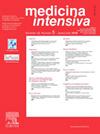在大流行期间,未感染SARS-CoV-2的危重病人的插管程序是否发生了变化?INTUPROS多中心研究的二次分析
IF 3.1
4区 医学
Q2 CRITICAL CARE MEDICINE
引用次数: 0
摘要
目的了解新冠肺炎大流行期间非SARS-CoV-2感染危重患者插管程序的变化。设计:对INTUPROS关于重症监护病房(icu)插管的前瞻性多中心观察性研究进行二次分析。在2019年4月至2020年10月期间,西班牙将设立43个icu。患者在大流行之前和期间,共有1515名非covid -19患者插管。感兴趣的主要变量:插管程序和药物,首次通过成功率,并发症和死亡率。结果分析大流行前插管患者1199例,大流行期间插管患者316例。在大流行期间,距插管的天数更少(OR 0.95;95% CI: 0.92-0.98),复位复苏袋(OR 0.43;95% CI: 0.29-0.63)和无创通气氧合(OR 0.51;95% CI: 0.34-0.76),减少使用血管造影(OR 0.55;95% CI: 0.33-0.92)和芬太尼(OR 0.47;95% ci: 0.34-0.63)。另一方面,非hfnc设备的氧合增加(OR 2.21;95% CI: 1.23-3.96),第一次使用视频喉镜检查(OR 2.74;95% CI: 1.76-4.24),更多地使用咪达唑仑(OR 1.95;95% CI: 1.39-2.72),依托咪酯(OR 1.78;95% CI: 1.28-2.47)和琥珀胆碱(OR 2.55;95% ci: 1.82-3.58)。第一次通过率更高(68.5% vs. 74.7%;p = 0.033)。术后主要并发症发生率无差异(34.7% vs 34.8%;P = 0.970)和住院死亡率(42.7% vs. 38.6%;p = 0.137)。结论COVID-19大流行改变了非COVID-19患者的插管程序,改变了氧合策略、药物和视频喉镜检查的使用,对并发症和死亡率没有影响。本文章由计算机程序翻译,如有差异,请以英文原文为准。
¿Cambiaron durante la pandemia los procedimientos de intubación de pacientes críticos sin infección por SARS-CoV-2? Análisis secundario del estudio multicéntrico INTUPROS
Objective
To determine the changes in intubation procedures of critically ill patients without SARS-CoV-2 infection induced during the COVID-19 pandemic.
Design
Secondary analysis of the INTUPROS prospective multicenter observational study on intubation in intensive care units (ICUs).
Setting
A numbre of 43 Spanish ICUs between April 2019 and October 2020.
Patients
A total of 1,515 non-COVID-19 patients intubated before and during the pandemic.
Interventions
None. Main variables of interest: Intubation procedures and medication, first-pass success rate, complications, and mortality.
Results
A total of 1,199 patients intubated before the pandemic and 316 during the pandemic were analyzed. During the pandemic, there were fewer days until intubation (OR 0.95; 95% CI: 0.92-0.98), reduced resuscitation bag (OR 0.43; 95% CI: 0.29-0.63) and non-invasive ventilation oxygenation (OR 0.51; 95% CI: 0.34-0.76), reduced use of capnography (OR 0.55; 95% CI: 0.33-0.92) and fentanyl (OR 0.47; 95% CI: 0.34-0.63). On the other hand, there was an increase in oxygenation with non-HFNC devices (OR 2.21; 95% CI: 1.23-3.96), in use of videolaryngoscopy on the first-pass (OR 2.74; 95% CI: 1.76-4.24), and greater use of midazolam (OR 1.95; 95% CI: 1.39-2.72), etomidate (OR 1.78; 95% CI: 1.28-2.47) and succinylcholine (OR 2.55; 95% CI: 1.82-3.58). The first-pass success was higher (68.5% vs. 74.7%; P = 0.033). There were no pre-post differences in major complications (34.7% vs. 34.8%; P = 0.970) and in-hospital mortality (42.7% vs. 38.6%; P = 0.137).
Conclusions
The COVID-19 pandemic modified intubation procedures in non-COVID-19 patients, changing the oxygenation strategy, the medication and the use of videolaryngoscopy, with no impact on complications or mortality.
求助全文
通过发布文献求助,成功后即可免费获取论文全文。
去求助
来源期刊

Medicina Intensiva
CRITICAL CARE MEDICINE-
CiteScore
2.70
自引率
20.00%
发文量
146
审稿时长
33 days
期刊介绍:
Medicina Intensiva is the journal of the Spanish Society of Intensive Care Medicine and Coronary Units (SEMICYUC) and of Pan American and Iberian Federation of Societies of Intensive and Critical Care Medicine. Medicina Intensiva has become the reference publication in Spanish in its field. The journal mainly publishes Original Articles, Reviews, Clinical Notes, Consensus Documents, Images, and other information relevant to the specialty. All works go through a rigorous selection process. The journal accepts submissions of articles in English and in Spanish languages. The journal follows the publication requirements of the International Committee of Medical Journal Editors (ICMJE) and the Committee on Publication Ethics (COPE).
 求助内容:
求助内容: 应助结果提醒方式:
应助结果提醒方式:


